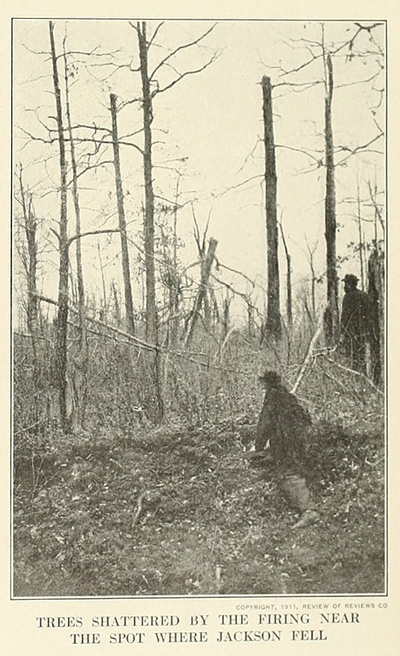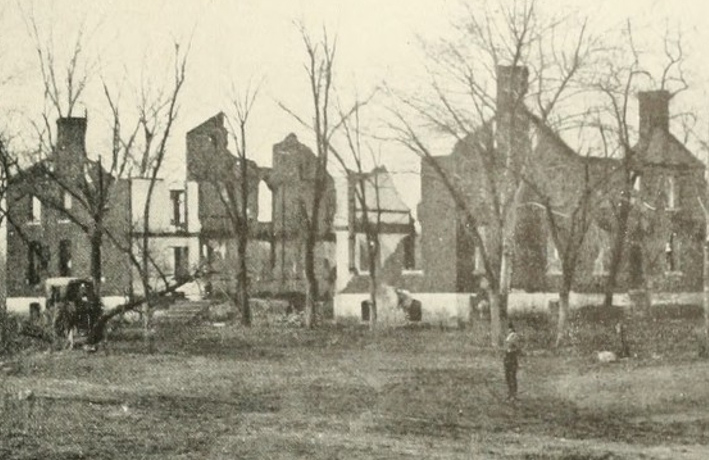Yet, Another Union Commander
The Battle of Chancellorsville was fought between April 30th and May 6th, 1863, near the city of Fredericksburg, Virginia, where the Confederates had scored a major victory in December. Union General Joseph Hooker, recently named Commander of the Army of Potomac, planned to launch a massive assault against Lee's Army of Northern Virginia by attacking them at the front and the rear. Hooker's Army was roughly twice the size of Lee's and was well rested and provisioned.
Lee Outsmarts Hooker
On May 1, 1863, Hooker launched his attack on Lee's Army at Chancellorsville. Lee, in an unconventional military move, decided to split his smaller army into two parts, leaving a small force at nearby Fredericksburg, Virginia, and confronting Hooker's assault with roughly 80% of his army. Union General Hooker, inexperienced and perhaps unconfident in handling such a massive force, ordered his forces to withdraw to defensive positions in the nearby forests around Chancellorsville in the wake Lee's assaults.
Jackson Crushes the Union Right; but is Shot by Friendly Fire
On May 2, 1863, Confederate General Stonewall Jackson attacked the right flank of the Union Army entrenched around Chancellorsville. Jackson marched his forces of 28,000 men 12 miles undetected to reach the Union right flank. At dinnertime, Confederate forces screaming their "rebel yell" stormed out of the forest and attacked the Union right flank. Union forces were totally unprepared and many were eating dinner. Within an hour, the right flank was totally disintegrated and was in full retreat. They suffered at least 2,500 casualties. Later that evening, however, General Stonewall Jackson was mistaken for Union cavalry and was shot in the arm as he rode out to investigate the feasibility of launching a nighttime attack on the Federals. Jackson contracted pneumonia and died on May 10th. Jackson's death was devastating to the Confederate cause and to Lee's battle strategies through the remainder of the war.
 |
The Approximate Location Where Stonewall Jackson was Shot |
Hooker's Incompetence
Despite the initial setback, Union forces were still in control. Nearly 76,000 Union soldiers were still in positions defending Chancellorsville compared to 43,000 soldiers available to the Confederacy. The two largest parts of Lee's Army of Northern Virginia were positioned on either side of Union forces that occupied an area of high ground known as Hazel's Grove. Luckily for the Confederacy, General Hooker ordered those soldiers, under the command of General Sickles, to a different position on a local road called the Plank Road. Confederate forces proceed to occupy the high ground, where they placed thirty heavy guns. At 5:30 in the morning on May 3, Confederate forces now under the leadership of J.E.B. Stuart (after Jackson was wounded and after the next in command, A.P. Hill, was also wounded) launched a massive attack on the Federal positions around Chancellorsville, aided by the newly installed guns. Fires were sparked in the woods around Chancellorsville, confusing soldiers and killing wounded soldiers rendered immobile. Confederate forces overwhelmed their Union counterparts and Hooker ordered a retreat. Hooker was wounded in the fighting, but refused to turn over command, despite being rendered unconscious for over an hour. Meanwhile, Union forces under John Sedgwick were defeated in their attempts to salvage the battle and the Union Army ultimately withdrew across the Rappahannock River on May 6.
 |
Ruins of the Chancellor House - Hooker Headquarters During the Battle |
Lee's Greatest Victory; Time to Invade the North
In what is considered one of the most decisive Confederate victories of the Civil War, Confederate forces suffered over 13,000 casualties, while Union forces suffered over 17,000. Confederate forces, however, suffered a much greater percentage of casualties. Hooker's reputation was forever tarnished in his handling of the battle. After the battle, he blamed the "incompetence" of his subordinate generals despite the fact that over half of his available soldiers were never deployed into combat. On the Confederate side, the battle is often called “Lee's greatest victory,” and gave him the feeling his army was destined to win the war. The victory at Chancellorsville gave Lee the confidence that his army could win in the North and resulted in his invasion of Pennsylvania and ultimately the Battle of Gettysburg.
Battle of Chancellorsville Activities